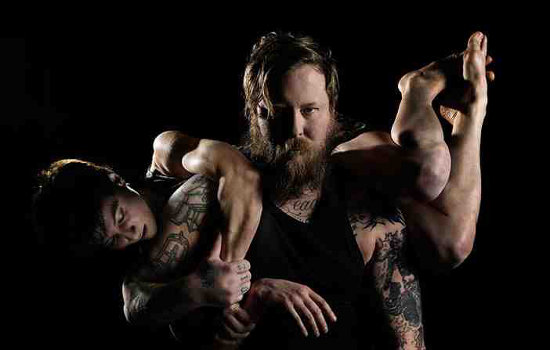Iona Kewney is awesome – there’s no denying it. Her physical, visceral, shamanic performance is an extraordinary blend of contemporary circus and radical dance – it is no surprise to learn that she trained at the legendary School for New Dance Development in Amsterdam, before moving on to Cirkuspiloterna in Sweden. She is a contortionist, and then some – her ludicrously supple and bendy body twisting into unbelievable shapes. In one early section of the show, she remains on her hands for so long – her gangly legs waving in the air and weaving around her torso into ever more convoluted shapes – that we start to believe that the human body is supposed to be this way up. At other points in the show she seems to become a bouncing frog, or a foal finding its feet, or a caterpillar morphing into a cocoon; and then again, she’s human – a human in a state of trance, or perhaps in the throes of a fit: shaking, twitching, her breath coming hard and fast, her head tossed from side-to-side, her face obscured by her hair. Not since I first saw Marcella Soltan of Russia’s BlackSkyWhite have I felt so impressed by the twisted shapes a human body can make. And she has muscles in places I didn’t even know you could have muscles…
This talented performer also has a background in visual art (a graduate of Duncan of Jordanstone art school in her native Scotland, and a veteran of the National Review of Live Art), which shows in the scenography of the piece, and the animation of the physical environment through both light and physical action. Objects take on totemic, fetishist values – a stack of cardboard boxes dived through, worn, kicked over. Dangling lace curtains that become a kind of bridal veil cum burqa, both concealing and revealing. A hanging rope is toyed with as much as it is used in any sort of regular circus manner: an ominous suggestion of execution or suicide.
In Black Regent, Kewney is partnered with musician Joseph Quimby (an ongoing artistic relationship established in 2010). Their physical differences are played upon throughout the piece, which starts magnificently with the big, burly, bare-chested Quimby bursting through a door at the back of the stage carrying the limp, lanky Kewney in his arms, echoes of King Kong and every other Beauty and the Beast story you’ve ever heard or seen. Later, he rocks her tenderly on a kind of hammock-swing placed below his music station, and in one rare moment of role-reversal, she tows him across the stage on a little wheeled trolley – his big form resplendent in a kitsch pink cloak (eat your heart out, Rick Wakeman). I would have welcomed a bit more subversion of the big-guy tiny-girl dynamic – she’s twitching at his feet or leaning on his chest too many times for my liking.
As for the music: mostly it is a little too Midi-synth-dominated for me – I was somehow expecting something rather more radical than the laptop-musician symphonic compositions that abound – but this a personal taste thing: he is no doubt a talented composer, and there are some sections that I love, usually the parts where synth melody is less important and a low drone dominates, or a stomach-churning drum and bass beat pulses. What I especially like is Quimby’s voice – a high, tender, almost falsetto voice that is a surprise coming from such a big man. A voice that, heavy on the echo and reverb, reminds me strongly of Icelandic group Sigur Ros.
So much to admire; so many amazing images; such a relentless physical performance that leaves you shell-shocked. Yet there are reservations. It’s an interesting combination of artists, and there is complicity and exchange onstage, but I don’t feel that this is an absolutely symbiotic musician-and-dancer relationship of the strength, say, of Spitfire Company’s One Step Before the Fall, seen at London International Mime Festival 2014. Despite the ongoing collaboration of the two performers, Black Regent feels somehow unfinished, unresolved, a work-in-progress. But maybe that’s what it is – an ongoing collaboration, an ongoing process. And perhaps that is more than enough. They are certainly a compelling couple, and this a show filled with images that will resonate for a long time to come.

